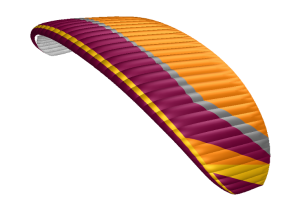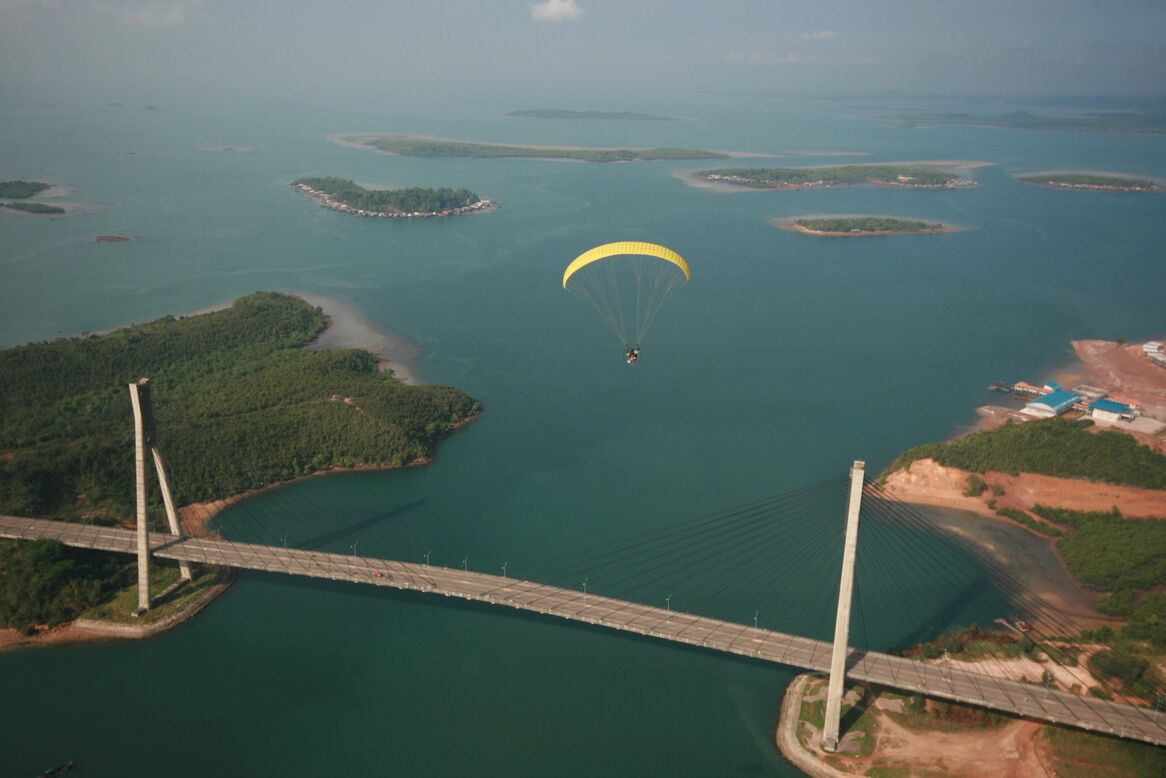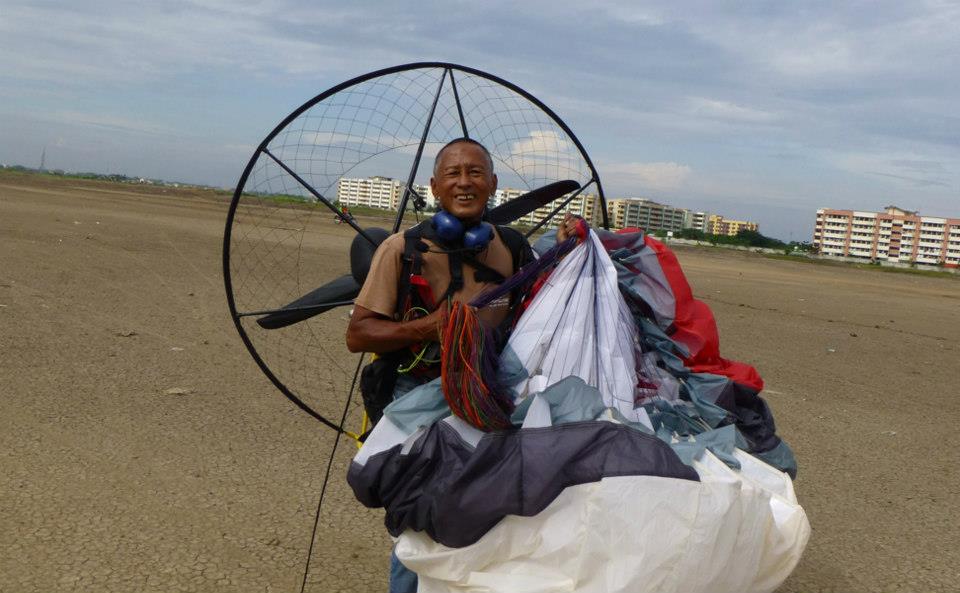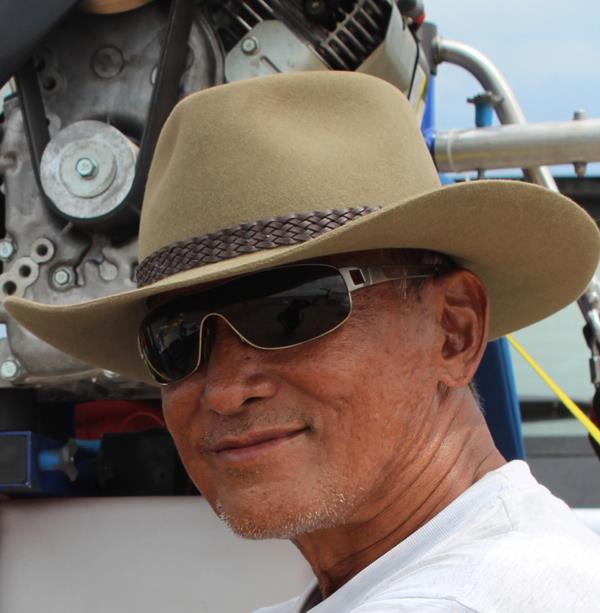The latest development in ultra light aviation, Paramotors (also termed Powered Paragliders) cobine the easy flying characteristic of the paraglider with the autonomy and range of powered flight. Paramotors are relatively easy to learn to fly, yet being foot launched they do not need and airfield to operate from they can be flown from an open, flat field with no nee dto find a hill site facing into wind or even to wait for the wind to blow. They are quickly and easily rigged and de rigged and once dismantled can be put in the boot of the car or taken to exotic locations and hand baggage.
A paramotor is a motorized paraglider. It is not an airplane and does not fly like one. The motor fits on the back of the pilots. This simplest of all powered aircraft consist of small – 2 stroke or 4 stroke petrol engine driving a propeller, worn like a back pack under a paraglider wing and providing thrust to take off, climb and maintain level flight. Once airborne, the paramotor can be used to motor along and watch the world go by beneach you or, if condition permit soared in thermal or lift to make long cross country flights. The motor can be stopped and restarted in the air – many types have electric starters – enabling the pilot to adapt his or her flight to the prevailing conditions.
With the paramotor unit disconnected before take off, the wing becomes just another paraglider, offering the freedom and excitement of engineless flight. Many paramotor pilots are paraglider pilots looking for more flexibility in their flying, many others are new to flying but become interested in paramotoring and pure paragliding flight.
However, tehere are photographs and video of a group of skydivers flying their parachutes off of small hills in eastern Montana in the late seventies. At about this same time, a handful climbers in the French Alps began to use ram air skydiving canopies to make safe and efficient descents from peaks after ascending technical routes. These parachutes weighted only eight ponds, flew at 20 mph, and were able to glide about three feet forward for every foot of altitude lost. By the mid – eighties, people realized there was a whole new challenge in prolonging the distance and duration of such as flights if one could find and lotler in areas of rising air like the hang gliders did.
With this challenge came many attempts to improve parachute glide performance by using non porous fabric, increasing the wingspan and modifying the shape and trim of the airfoil. As each new design was tested, unexpected changes in the flight characteristics often appeared whi9ch demanded different pilots skills and techniques. Ideas which worked well were produced in large numbers to meet the demands of a growing population of paraglider pilots. The sport was well established in Europe by 1986.
For several years, a wide range of equipment was developed in the US, Europe and Asia. Afew gliders with very dangerous flight characteristics were hastly distributed in the international market while other manufacturers conducted thorough tests with pilot safety in mind. In the US, at least three manufacturers of skydiving equipment were involved in developing and marketing paragliders which were extremely safe and stable, but which lacked the performance of the European designs. Since then, all three have returned their attention exclusively back to the skydiving market, primarily for economic reasons. By the early nineties, there were fewer radicak new designs emerging and production was concentrated on paragliders with very stable handling characteristics for the general flying population.
Distinctions emerged among wings intended for students, intermediate / recreational pilot, and competition pilots. Standardizes procedures for testing and certifying paragliders were established in France and Germany which now represent the benchmark for manufacturers around the world. Today there are flew pilots willing to fly an uncertified gliger, and there are many regulated flying sites where the French or Germany certification is required. It is interesting to note that, although paragliders evolved from ram air skydiving parachute technology, the two sports have not completely diverged. On fact, they have begun to come full – circle in some and thin profile airfoils which allows for higher speeds, better glider performance and greater aerodynamic efficiency.
There features which were develop for paragliders, are now being incorporated back into skydiving parachute. Beware that, even though paragliders may look similar to some skydiving canopies at first glance, they have different flight charachteristic which require completely different pilot technique. Proper instruction is an absolute must even for hang glider pilot or a highly experience skydiver. A student paraglider pilot spend hours learning how to ground handle and launch a wing in different wind conditions. There is also a variety of procedures for managing the dynamic shanges in flight characteristic which commonly occur when paragliders are flown in turbulent air. Understanding what is taking place and practicing the appropriate response under the direction of an instructor is essential for pilot safety.
In addition to learning how to launch, land and control a paraglider in flight, a student spends considerable time studying meteorology on both the large and small scale. For example, it is critical to understand the effect that terrain features have on the movement of air. It is also important for pilots to know how changes in cloud condition, atmospheric stability and even the time of say can dramatically influence the outcome and safety of a flight. Considering the complexity of the weather. It’s no wonder that even the most experienced pilots feel they are in a constant state of learning throughout a lifetime of soaring.
The most important requirement for safe and successful paragliding is a proper attitude and good judgement. A pilot flying the most stable glider on the market, off the safest hill on the planet and in a calm wind is not guaranteed a safe flight if concentration is lost poor decision are made, or a complacent attitude prevalls. Shen learning to fly listen carefully to your instructor and other pilots. Read what is remommended and then more. Pay close attention to what you are doing and dluble check all your equipment before launch.
Spend considerable time studying the clouds and the wind speed and direction for changers, trends and cycles. Watch how these changes affect the flight of other pilots. Once you are skilled enough to earn a pilot certification and fly on your own, don’t let the learning stop. Review emergency procedures frequently in your mind and always leave your self a “way out” should the conditions of your flight change.
Do not be in hurry to buy a high performance equipment. Allow yourself a couple hundred hours to experience different conditions and fly at different sites before complicating your life with equipment that requires more attention and quicker responses than you can provide as a novice,. While in the air, know where all the other gliders are at all times. Constantly think and plan a head. You must be in control of the glider, not vice versa. Most of all, trust your instincts. Do not fly if something doesn’t feel right,. There is much truth to the old saying that it’s better to be on the ground wishing you were in the air than to be in the air wishing you were on the ground.
Respect the weather and what it can do. Have fun and let’s be careful out there.








ENJOY THE BEAUTY OF INDONESIA
JOIN US AND CHOOSE YOUR DESTINATION
About Us
We are ready for flying with you
Starting with Paragliding since 1993, we tried to promote so many beautiful and challenge sites in Indonesia. Most of the area are important tourism object for domestic and international tourism. The sites are upgrading with Paragliding activities.
In 2002 we found the other potential aero activities which is more cheap than the ultra light and also easy to carry with airlines. “Paramotor”. The site for flying with Paramotor even easy compare with Paragliding which we have to find hill or mountain. Flat area as football field without any obstacle around is enough for enjoying everything from the air with Paramotor.
“Para” means Parachute and Motor means engine to be a power for flying in flat area. With Paramotor, every pilot could join the scenery of the area where they are flying even they could go further and higher with the engine.
We started to make international Paramotor Even for Borobudur International Festival on June 2003 and we continue with other international event in other potential area. Yes, there is still some problem for pilots to bring their engine to overseas due to the security systems in the airport but the only way to avoid this problem is make your engine clean without any smell.The other way is you have to take out all as spare part to be save.
Come and enjoy the beauty of Indonesia scenery and bring your engine.
We are ready for flying with you and we will arrange domestic flight, hotels and land transportation.
CONTACT US
For any inquiries, do not hesitate to contact us. Our team will respond your email shortly. Enjoy the beauty of Indonesia











